8 Varieties Of Weeping Miniature Trees
In the world of aesthetic and natural beauty, various varieties of large and small ornamental plants secure their place. These plants are admired for their flowers, patterns, foliage, size and various other characteristics. Among these beautiful varieties of ornamental plants weeping miniature trees is greatly important for drawing my attention towards its graceful and elegant appearance, blushing in the garden landscape.
Weeping Miniature trees are charming and versatile additions to any garden or pathways. They offer the graceful draping branches of a full-size weeping tree in a small form. These miniature trees typically mature at heights between 6-10ft, making them perfect for smaller spaces.
The breakdown of Weeping Miniature is:
- Weeping- They are called weeping as the trees have flexible branches that cascade downwards, creating a weeping appearance.
- Miniature- In fact they are called miniature trees due to their small size. Unlike their full-size counterparts, weeping miniature trees are bred or selected to stay much smaller, typically maturing between 6-10 ft tall. This makes them ideal for small spaces in gardens and pathways.
Several flowering varieties of weeping miniature trees are also found. These flowering small trees, besides increasing the aesthetic value of the place with vibrant colors, attract various pollinators to the garden that ultimately benefits nearby plants. Increase their production by aiding the process of pollination in them.
Importance of Weeping Miniature Trees
Weeping miniature trees as described above can be planted as a beautiful addition in the garden. However these trees are also important for their various other unique characteristics such as:
- Weeping Miniature trees are relatively low maintenance. They typically require less pruning than their full-sized form due to small size.
- Their main attribute is their beauty. The dropping branches create a graceful, elegant look that adds a touch of drama or softness to landscape.
- While other trees are too large in size and require a very sufficient amount to grow properly, weeping miniature trees offer manageable size, making them perfect for smaller gardens, balconies or containers.
- There is a wide range of varieties of weeping miniature trees offering options with beautiful flowers, interesting foliage colors or even edible fruits in some varieties.
- The edible fruits produced by some varieties can be consumed by humans or provide food to small wild life, increasing the overall ecosystem. Thus these plants can be selected according to one’s own preference and likeness.
For more information about Houseplants you can visit: Calathea Yellow Leaves
Types of Weeping Miniature Trees
Weeping Miniature Trees are versatile woody plants that are easy to care for. They are classified into various categories and multiple classifications, however general types or categories of these trees are as follows.
1. Deciduous Flowering
Deciduous flowering weeping trees are a delightful combination of three different attributes that are deciduous, flowering and weeping. Being deciduous these trees lose their leaves in the fall. This dropping of leaves is known as senescence, that is survival mechanism under unfavorable conditions. This allows plants to survive cold winters by going dormant and conserving energy. In spring new leaves are produced giving a fresh look to plants.
This cycle continues with a burst of color in spring. The weeping trees put on a spectacular shawl of flowers in the spring with leaves adding another layer of beauty that attracts pollinators like bees and butterflies to the garden. The flowers come in a variety of colors, shapes and sizes depending on the variety being selected.
Thus, weeping miniature deciduous flowering trees have branches cascading downwards that creates a graceful, elegant and colorful look blooming throughout the spring and in winter a period of bare branches is seen.
Examples: Dwarf Weeping Cherry, Weeping Forsythia, Weeping Redbud etc.
2. Evergreen Conifers
Evergreen Conifers weeping miniature trees are ornamental plants possessing qualities of evergreen, conifers and weeping miniatures that make them excellent choices for small spaces where we want foliage round the year. Being an evergreen variety it is clear that they are versatile and comparatively more tolerant than other varieties.
Unlike deciduous trees that lose their leaves in fall, evergreen retain their foliage throughout the year that provide year-round greenery, even during colder months. Evergreen conifers weeping miniature trees possess needles instead of broad leaves. These needles are typically long, thin and scale-like, offering a distinct texture and appearance. Moreover they reproduce using cones instead of flowers, which contain seeds for new plants to grow. That’s why they are called conifers(a group of cone bearing trees and shrubs).
Hence evergreen conifers weeping miniature trees provide a year round foliage over cascading branch structure, providing a rich look to the garden.
Example: Weeping Hemlock.
3. Deciduous with Ornamental Foliage
Above, I have described deciduous weeping miniature trees that produce colorful blooms, but now these are deciduous trees with ornamental foliage instead of flowers combining seasonal charm of deciduous trees with attracting leaf displays. Ornamental foliage is basically covering of leaves with interesting shape and fall color changes.
These trees lose their leaves in the fall, entering a dormant state during winter. It allows them to survive colder temperatures and conserve energy. In spring it produces fresh new leaves again oftenly in vibrant colors. This cycle creates a dynamic look throughout the year. Their key feature is beautiful leaves. Beyond simple green foliage it shows a cascade of unique colors, shapes and textures throughout the season.
Examples include Weeping Redbud with lobed leaves, Japanese Maple with dissected leaves, Larix with needle-like leaves.
Many deciduous trees with ornamental foliage show beautiful fall colors before losing their leaves such as.
- Red, Oranges and Yellow color palette shown by trees like weeping maple and some weeping birches.
- Purples and Burgundies colors are shown by varieties like weeping beech such as Fagus.
Considerations
- Different deciduous trees have varying sunlight requirements. So before planting a variety in certain regions, it must be considered how much sunlight it requires.
- If fall color is priority, select a variety known for its vibrant display and ensure it gets enough sunlight to trigger the color change.
- Water requirements can also vary depending upon the variety. The ornamentals must be watered adequately to get the best look. Don’t let the plant undergo underwater state as it can cause wilting with rough texture or over-watered state as it can cause root rot or other fungal diseases.
Beautiful Varieties of Weeping Miniature Trees
There are various beautiful varieties of weeping miniature trees that can be planted in the garden to increase the overall aesthetic value and enhance the ecosystem of a place. Here I have enlisted a few of these varieties with their hardiness zone, category in which they fall and their mature size.
- Dwarf Weeping Cherry
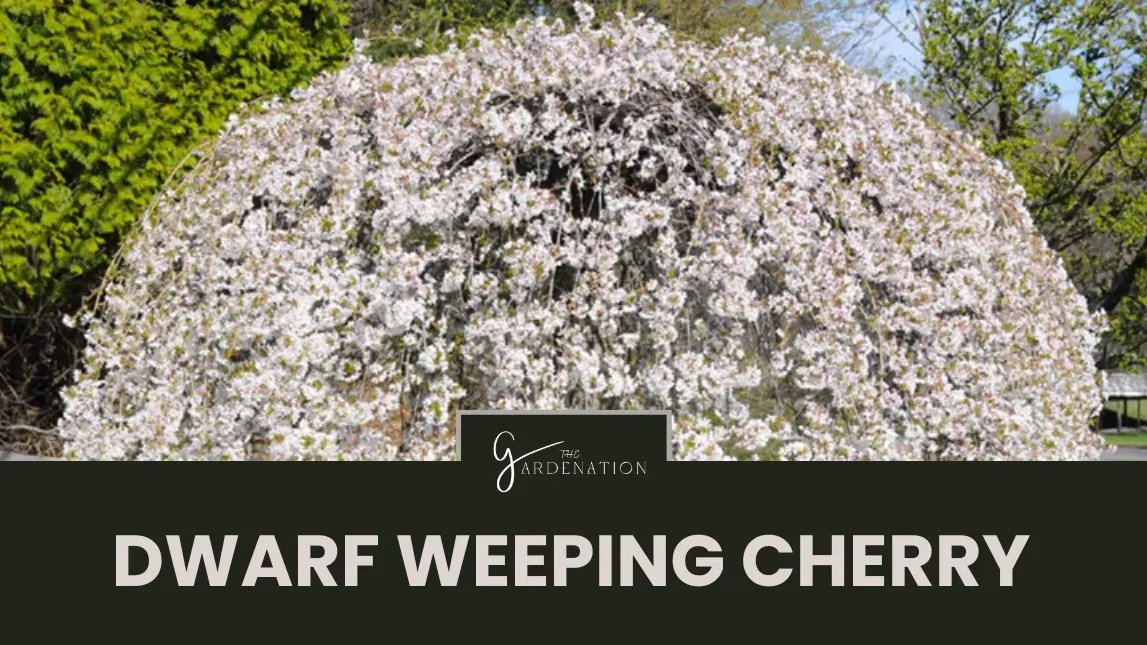
Prunus glandulosa ‘Nana’
- Category- Deciduous Flowering
- USDA Hardiness Zone- 4-8
- Mature Size- 6-8 ft Height* 8-10 ft width
The Dwarf Weeping Cherry is a popular choice for weeping miniature trees, offering delicate beauty in compact size. This miniature tree is known for its delicate pink blossoms having 5 petals and are arranged in clusters that appear in early spring, before the emergence of leaves. After the flowers fade, the tree produces small, green, oval-shaped leaves. In fall these leaves turn a dull yellow color before dropping.
Adorned with beautiful flowers and leaves, its branches are bent downwards creating an elegant form. This variety is specifically chosen for its compact size. Dwarf weeping cherry has a moderate growth rate, typically growing 6-12 inches per year when young. But as the tree matures this rate slows down.
These plants prefer full sun, at least 6 hours of direct sunlight daily. It must be watered regularly especially during growing season and hot weather. But always allow the top inch of soil to dry out before watering.
- Weeping Forsythia
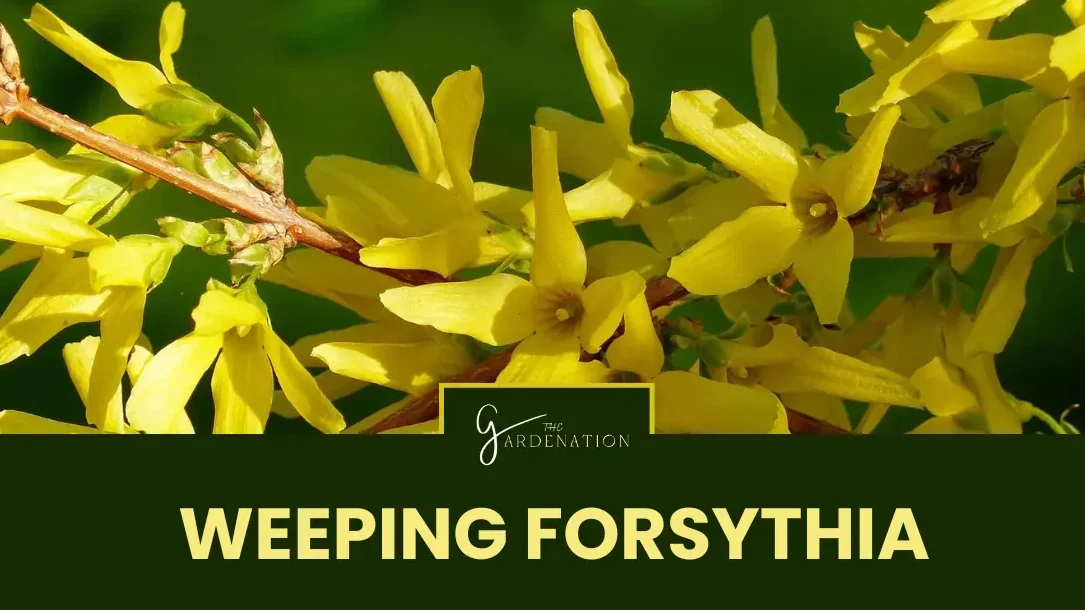
Forsythia intermedia ‘Pendula’
- Category- Deciduous Flowering
- USDA Hardiness Zone- 5-8
- Mature Size- 8-10 ft * 8-10 ft
The Weeping Forsythia is an eyecatcher among weeping miniature trees. It provides a vibrant display of yellow flowers in early spring, surrounded by cascading green foliage. Like dwarf cherries, its vibrant yellow, four petaled flowers appear in clusters in early spring before the emergence of leaves. After the flowers fade, the tree produces bright green, oval-shaped foliage adding fresh and airy feel throughout the summer.
As per unique characteristic of weeping trees the whole show appears as downward dropping of colors. This variety is perfectly suited for smaller spaces. It shows moderate growth rate, typically growing 12-18 inches per year when young and the growth rate slows down as the tree matures. Prefer similar growing conditions as weeping dwarf cherry trees but it can tolerate partial shade.
- Weeping Redbud
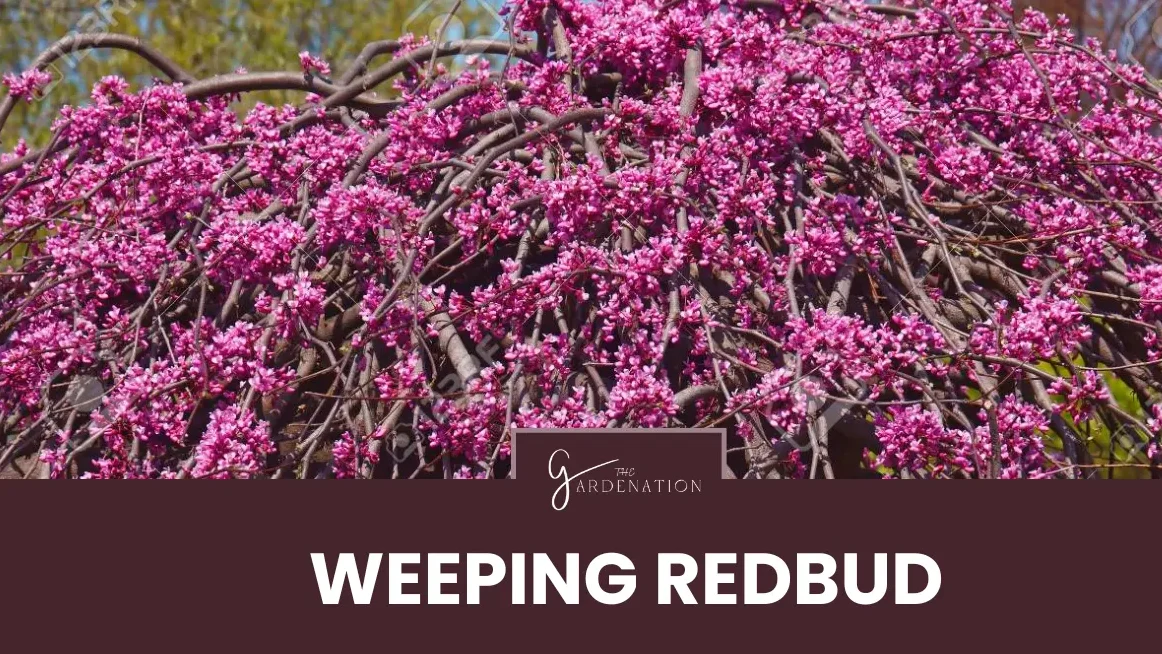
Cercis canadensis ‘Cessator’
- Category- Deciduous Flowering
- USDA Hardiness Zone- 5-8
- Mature Size- 8-10 ft * 8-10 ft
The Weeping Redbud is a beautiful and low maintenance weeping miniature tree that offers a touch of elegance and spring beauty. In early spring, before the emergence of leaves, the weeping Redbud produces a charming display of small pea-like, pink-purple flowers cascading along the weeping branches.
Following the production of flowers, the tree produces heart-shaped, green leaves. These leaves remain healthy throughout the summer season and when fall starts the foliage transforms into yellow color giving a temporary appealing look. This variety also has moderate growth rate, growing 12-18 inches per year that slows down at mature age.
It prefers full sun for best blooming but can also tolerate partial shade, in this case it will reduce flowering. Improper watering can also badly affect the blooming and overall plant health.
- Weeping Fringe Tree

Chionanthus virginicus ‘Pendula’
- Category- Deciduous Flowering
- USDA Hardiness Zone- 5-8
- Mature Size- 8-10 ft * 8-10 ft
The Weeping Fringe Tree is a graceful and elegant addition to any garden offering fragrant flowers and weeping foliage. It blooms during late spring and early summer. During this period, the weeping fringe produces clusters of delicate, white, fringe like flowers. These fragrant blooms hang gracefully from the branches, adding a touch of elegance and delightful scent to the garden.
Following the flowering period the tree shows dark green, glossy, pinnate leaves, this foliage adds a dense and lush feel throughout the summer. In fall these leaves transform into a vibrant color before dropping, presenting another layer of visual interest.
- Weeping Hemlock
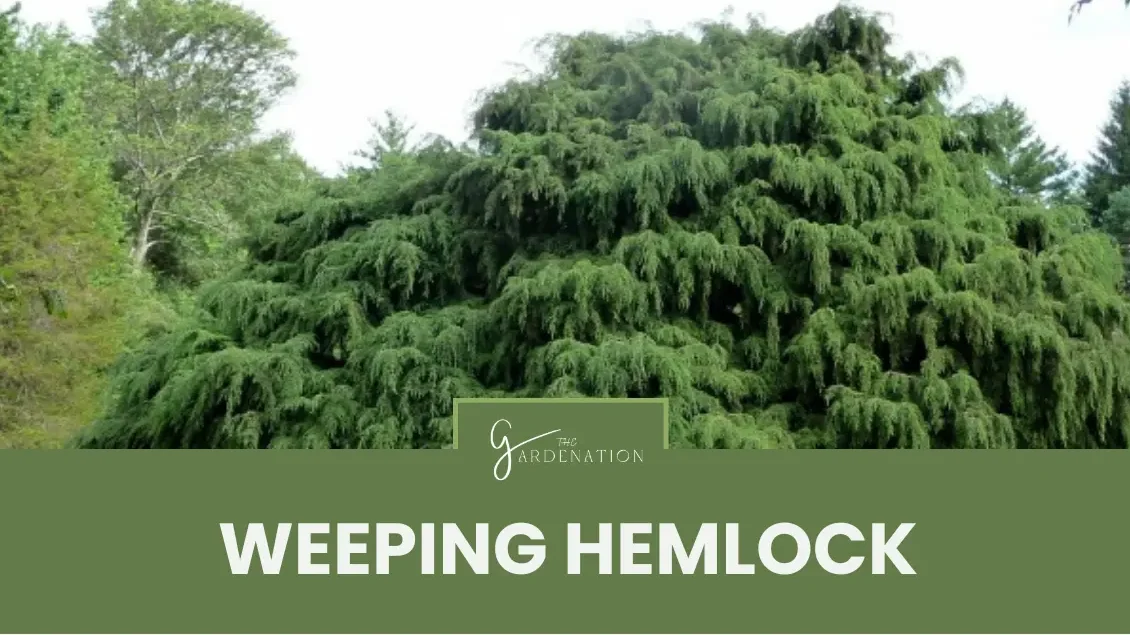
Tsuga canadensis ‘Pendula’
- Category- Evergreen Conifer
- USDA Hardiness Zone- 4-7
- Mature Size- 10-15 ft * 6-8 ft
The Weeping Hemlock is a beautiful evergreen conifer with a cascading weeping form. It offers a year round green foliage and a graceful presence in the garden, even in its miniature size. It boasts a graceful weeping habit. The branches of this variety elegantly cascade downwards, creating a soft and flowing form.
Defining its features, it has soft, feathery, green needles that cascade downwards along the branches. These needles remain green throughout the year, providing winter interest and a lush feel in the garden. Weeping hemlock have a slow growth rate, typically growing 6-8 inches per year. This slow growth rate makes them a low maintenance variety.
Unlike deciduous flowering trees in this class, weeping hemlock prefer partial shade to full shade. Too much direct sun can scorch the needles. They prefer moist, well drained and slightly acidic leaves. Regular watering during early stages and hot weather is recommended.
- Weeping Japanese Maple
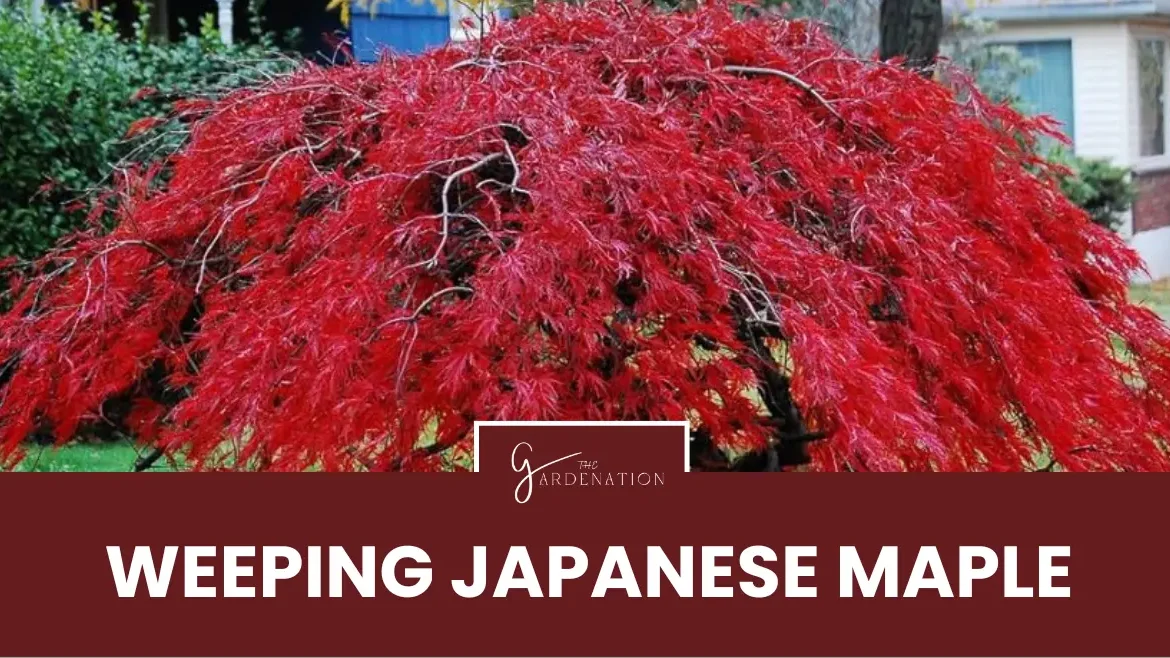
Acer palmatum dissectum ‘Virdis’
- Category- Deciduous Ornamental Foliage
- USDA Hardiness Zone- 5-8
- Mature Size- 6-8 ft * 6-8 ft
The Weeping Maple is praisable variety in weeping miniature trees. It shows an amazing combination of cascading branches, delicate foliage and vibrant seasonal color changes. Its defining feature is the finely divided, lace-like leaves. These leaves come in various shades of green depending on the specific variety. Some of these varieties includes,
- Green- Acer palmatum dissectum ‘Virdis’ offers stunning green foliage throughout the summer
- Red- Varieties like Acer palmatum dissectum ‘Crimson Queen’ show fiery red leaves.
- Purple- Acer palmatum dissectum ‘Garnet’ displays beautiful burgundy foliage during the fall season.
The varieties are deciduous and show seasonal change of leaves color that eventually drops in fall and winter. The falling leaves also provide a dreamy look to the place. These trees have a slow to moderate growth rate 6-12 inches per year when young. This slows down as the tree matures. The Weeping Japanese Maple generally prefers dappled sunlight or morning sun with afternoon shade. Too much direct sunlight can badly affect its leaves.
- Threadleaf Weeping Spruce
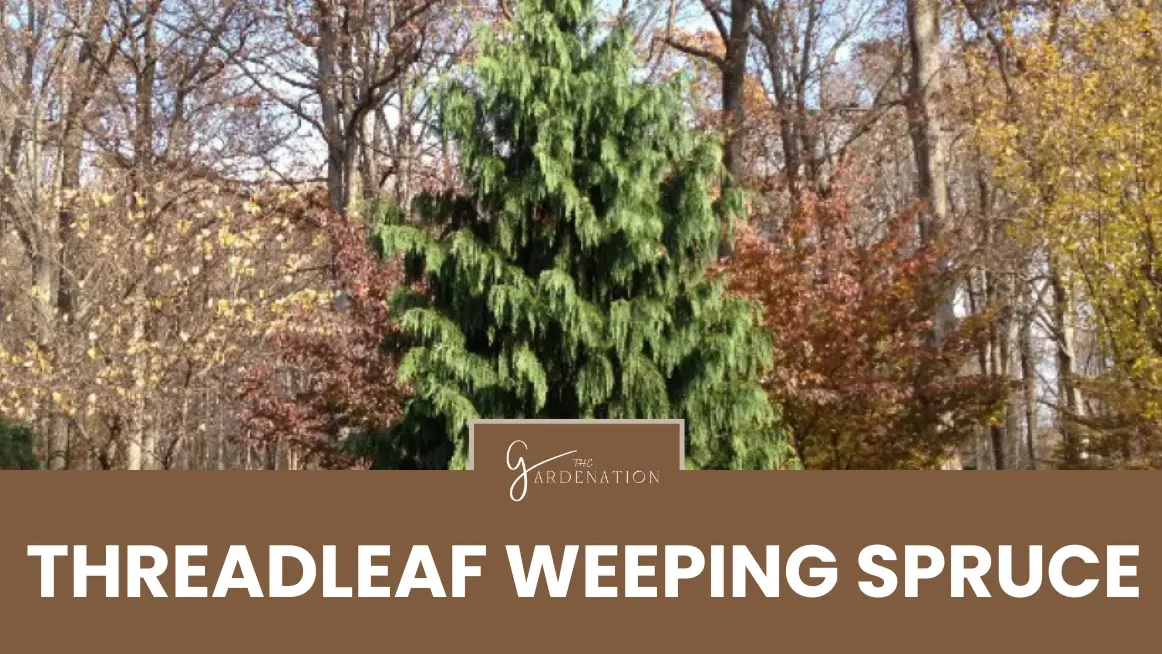
Picea abies ‘Inversa’
- Category- Evergreen Conifer
- USDA Hardiness Zone- 4-7
- Mature Size- 8-12 ft * 3-5 ft
The Threadleaf Weeping Spruce is a unique and eye-catching weeping miniature conifer. It offers a unique combination of soft thread like foliage and graceful cascading form, in compact size. Just like other weeping trees it shows the growth habit of branches cascading downwards. The defining feature of this variety is thread-like, bright green needles. These soft needles hang loosely from the branches, creating a feathery and wispy texture.
They have a very small size and are suitable for small gardens, foundation planting and even containers. They have a very slow growth rate, growing only 4-6 inches per year. This makes them relatively low maintenance and very easy to care for.
- Weeping Larch

Larix decidua ‘Pendula’
- Category- Deciduous Ornamental Foliage
- USDA Hardiness Zone- 2-7
- Mature Size- 10-15 ft * 6-8 ft
The Weeping Larch is a fascinating and unique choice for a weeping miniature tree. It offers a combination of soft needles in spring, a graceful weeping form and the unusual characteristic of being a deciduous conifer, losing its needles in fall. In spring, the tree produces soft, bright green needles that resemble traditional evergreen conifers. As summer progresses, the needles may turn a light shade of green.
Unlike most conifers, the Weeping Larch sheds its needles in fall. Before dropping, the needles transform into a beautiful golden yellow color offering a final burst of color before winter. They have a moderate growth rate of 12-18 inches per year when young. Overall it is an excellent choice in the world of miniature weeping trees and the shedding of its leaves during fall with mild breeze
These are a few varieties of weeping miniature trees. Here I have described their appearance in favorable zones so one can make the right choice while selecting them. They require regular traditional care and not too much maintenance. However they prefer moist well drained soil. Amend the soil with organic matter for better plant health. Minimal pruning of these plants is necessary as they are used as ornamental plants. Overall these plants are excellent choices and an interesting addition to the landscape.
Frequently Asked Questions
Is There Any Cultural Importance of Weeping Miniature Trees?
The concept of weeping miniature trees is not particularly found in cultures. However two varieties Bonsai and Penjing, the practice of cultivating these miniature trees is widely found in Japan and China respectively. These are only two examples some other cultures may have importance, but weeping miniature trees as specific terms might not have deep cultural roots.
Why Weeping Miniature Trees Smaller in Size?
The reason is it could be due to natural growth habits or grafting techniques. Many varieties have slower growth rate and smaller mature sizes due to genetic predisposition. Many cultivars are specifically chosen and bred to get smaller and compact varieties. While most weeping trees are created through grafting these are normally varieties that are maintained to compact sizes for smaller spaces.
Conclusion
Weeping Miniature trees are charming and versatile additions to any garden or pathways. They offer the graceful draping branches of a full-size weeping tree in a small form. These miniature trees typically mature at heights between 6-10ft, making them perfect for smaller spaces. Several flowering varieties of weeping miniature trees are also found. These flowering small trees, besides increasing the aesthetic value of the place with vibrant colors, attract various pollinators to the garden that ultimately benefits nearby plants.

